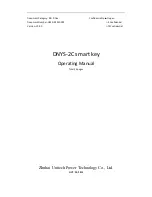
Portable Calibration Baths
Menu Guide
41
•
ID is a name to identify the reference probe.
•
Probe Calibration is the date the reference probe was calibrated.
•
PRT Type is the method used to characterize the reference probe.
•
RTPW, A, B, C, A4, and B4 are coefficients for a PRT characterized
according to the ITS-90 standard. Depending on the calibration, some
coefficients might not be used, in which case they must be set to 0.
•
R0, Alpha, Delta, and Beta are coefficients for a PRT characterized that
use the Callendar-Van Dusen method.
(Setup > Probe > Reference Probe)
Test Calculation
Test the reference probe temperature calculation.
Use this function to ensure that the probe coefficients are correct. Enter a
resistance and compare the calculated temperature to values given on
the PRT’s report of calibration.
(Setup > Probe > Reference Probe)
Program Probe
Copy the probe coefficients into the reference probe’s memory (INFO-
CON).
This function should only be used by a qualified calibration technician.
The password is required to perform this operation.
(Setup > Probe)
DUT
Configure the test sensor.
•
DUT Type is the type of sensor. The Input Module can measure an RTD,
thermocouple, or 4–20 mA transmitter. Different parameters are shown
below depending on the DUT Type.
•
RTD Type is the specification to which the RTD conforms. Choose
PT100-385 for an RTD that conforms to IEC 60751 or ASTM E 1137.
Other options are PT100-392 for an
α
0.00392 type PRT, PT100-JIS for
an RTD conforming to JIS C 1604, and NI-120 for a 120
Ω
nominal nickel
sensor.
•
Wires is the number of lead wires of the RTD.
•
Thermocouple Type specifies the type of thermocouple by letter
designation.
•
Loop Power controls whether the Input Module supplies dc voltage to the
transmitter. If the transmitter operates from a separate power source, set
Loop Power to OFF.
•
Span, Offset, and Unit can be used to convert the measured current to
some other quantity. The formula is as follows, where Input is the current
in mA and Reading is the value shown:
Reading = Input - 4 x Span + Offset
16
For example, if the transmitter draws 4 mA while at 0
°
C, and 20 mA at
100
°
C, set Span to 100, Offset to 0, and Unit to “
°
C”. To show the actual
current in mA, set Span to 16, Offset to 4, and Unit to “mA”.
www.
.com
1.800.561.8187
















































